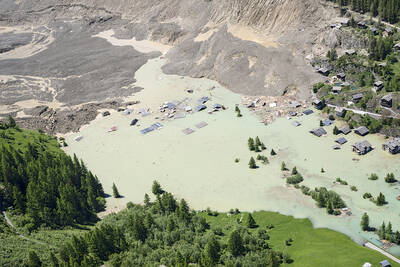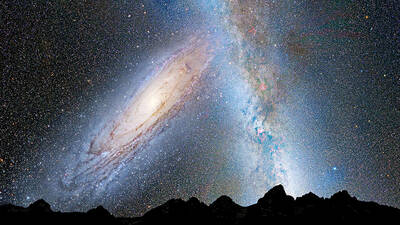The last piece of privately owned land in the strategic Svalbard archipelago in the arctic is up for grabs, a property likely to entice China, but which Norway does not intend to let go without a fight.
The archipelago is located halfway between mainland Norway and the North Pole, in an arctic region that has become a geopolitical and economic hotspot, as the ice melts and relations grow ever frostier between Russia and the West.
For 300 million euros (US$326 million), interested parties can acquire the remote Sore Fagerfjord property in southwestern Svalbard.

Photo: Reuters
Measuring 60km2 — about the size of Manhattan — the property is home to mountains, plains, a glacier and about 5km of coastline, but no infrastructure.
“It’s the last private land in Svalbard and, to our knowledge, the last private land in the world’s high arctic,” said lawyer Per Kyllingstad, who represents the sellers.
“The Chinese are naturally potential buyers since they’ve been showing a real interest in the arctic and Svalbard for a long time,” he said, adding that he had received “concrete signs of interest” from the nation.
Since China’s 2018 white paper on the arctic — a sign of its interest in the region — the nation has defined itself a “near-arctic state” and plans to play a growing role in the region.
Svalbard is governed by a 1920 international treaty that leaves ample room for foreign interests.
It recognizes Norway’s sovereignty over Svalbard, but citizens of all signatories — including China — are equally entitled to exploit the region’s natural resources.
Russia has maintained a coal mining community on Svalbard, via the state-run company Trust Arktikugol, for decades, but times have changed.
Keen to protect its sovereignty, Norway would not look kindly on the Sore Fagerfjord property falling into foreign hands.
Especially hands in China, which the Norwegian intelligence services say poses the biggest security risk to the Scandinavian nation after Russia.
The Norwegian attorney general has therefore ordered the owners — a company controlled by a Russian-born Norwegian, according to local media — to call off the planned sale.
“The land can’t be sold without the Norwegian authorities’ approval,” Norwegian Minister of Trade and Industry Cecilie Myrseth said.
“Nor is it possible to hold negotiations about the property,” she added.
That argument is based on clauses of an old loan granted by the state in 1919. Kyllingstad insists the clauses’ statute of limitations has expired.
The Norwegian state owns 99.5 percent of Svalbard and has declared most of the land, including the Sore Fagerfjord property, protected areas where construction and motorized transport, among other things, are prohibited, but the sellers do not see things that way, and cite the 1920 treaty.
“All parties [who signed the treaty] have the same rights,” Kyllingstad said, adding that Norway had built housing, an airport and a harbor in Longyearbyen, the archipelago’s main town.
“Imagine if Norway now adopted rules limiting the activities of Russian holdings,” he said. “It would be World War III.”
Andreas Osthagen of the Fridtjof Nansen research institute said that the Sore Fagerfjord land has “minimal” economic value and its possible sale does not represent “a huge threat” to Norway, but he added that “owning land on Svalbard could have a strategic value in 50 or 100 years.”
In the meantime, any mention of possible Chinese interest in Svalbard property raises “a red flag to force the Norwegian authorities to do something,” he said.
The Norwegian government in 2016 paid 33.5 million euros to acquire the second-last piece of private land on Svalbard, near Longyearbyen, which was also reportedly being eyed by Chinese investors.
Critics subsequently accused the government of being misled over unsubstantiated arguments.
In 2018 and 2019, the state had already engaged in negotiations to buy Sore Fagerfjord, but the talks collapsed over the price.
Myrseth said the option was still open if the terms were “realistic.”

The collapse of the Swiss Birch glacier serves as a chilling warning of the escalating dangers faced by communities worldwide living under the shadow of fragile ice, particularly in Asia, experts said. Footage of the collapse on Wednesday showed a huge cloud of ice and rubble hurtling down the mountainside into the hamlet of Blatten. Swiss Development Cooperation disaster risk reduction adviser Ali Neumann said that while the role of climate change in the case of Blatten “still needs to be investigated,” the wider impacts were clear on the cryosphere — the part of the world covered by frozen water. “Climate change and

Poland is set to hold a presidential runoff election today between two candidates offering starkly different visions for the country’s future. The winner would succeed Polish President Andrzej Duda, a conservative who is finishing his second and final term. The outcome would determine whether Poland embraces a nationalist populist trajectory or pivots more fully toward liberal, pro-European policies. An exit poll by Ipsos would be released when polls close today at 9pm local time, with a margin of error of plus or minus 2 percentage points. Final results are expected tomorrow. Whoever wins can be expected to either help or hinder the

DENIAL: Musk said that the ‘New York Times was lying their ass off,’ after it reported he used so much drugs that he developed bladder problems Elon Musk on Saturday denied a report that he used ketamine and other drugs extensively last year on the US presidential campaign trail. The New York Times on Friday reported that the billionaire adviser to US President Donald Trump used so much ketamine, a powerful anesthetic, that he developed bladder problems. The newspaper said the world’s richest person also took ecstasy and mushrooms, and traveled with a pill box last year, adding that it was not known whether Musk also took drugs while heading the so-called US Department of Government Efficiency (DOGE) after Trump took power in January. In a

It turns out that looming collision between our Milky Way and Andromeda galaxies might not happen after all. Astronomers on Monday said that the probability of the two spiral galaxies colliding is less than previously thought, with a 50-50 chance within the next 10 billion years. That is essentially a coin flip, but still better odds than previous estimates and farther out in time. “As it stands, proclamations of the impending demise of our galaxy seem greatly exaggerated,” the Finnish-led team wrote in a study appearing in Nature Astronomy. While good news for the Milky Way galaxy, the latest forecast might be moot